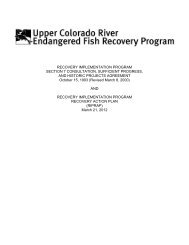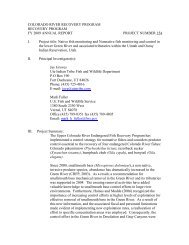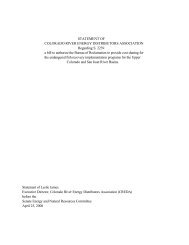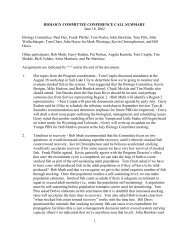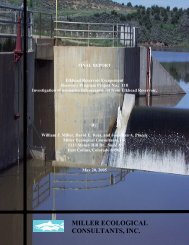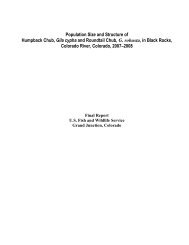K. R. Bestgen, K. A. Zelasko, and G. C. White. Monitoring ...
K. R. Bestgen, K. A. Zelasko, and G. C. White. Monitoring ...
K. R. Bestgen, K. A. Zelasko, and G. C. White. Monitoring ...
Create successful ePaper yourself
Turn your PDF publications into a flip-book with our unique Google optimized e-Paper software.
during the same sampling pass, 933 fish were recaptured only once, while 71 unique fish were<br />
recaptured 146 times (67 of which were recaptured twice <strong>and</strong> 4 were recaptured three times). Of<br />
those 1,004 individuals, 118 (11.8%) were ≥ 400 mm TL at stocking (an adult fish, USFWS<br />
2002), but 374 (37.2%) were ≥ 400 mm TL upon recapture, indicating growth of some<br />
individuals between time of stocking <strong>and</strong> last recapture but relatively few were stocked as adults.<br />
Maximum change in length over the 2006–2008 period was 74 mm TL; that 350 mm TL<br />
individual was captured on the first sampling occasion in 2006 <strong>and</strong> was 424 mm TL when<br />
recaptured on the last sampling occasion in 2008.<br />
Change in length data were somewhat suspect as 269 of 1,004 recaptured fish (27%)<br />
were apparently shorter than when released by an average of 9.6 mm TL (1 to 60 mm); that total<br />
<strong>and</strong> mean value did not include two fish where a recording error was assumed (e.g., 440 at<br />
release, 342 at recapture). In addition, 17 of the 1,004 recaptured fish (1.7%) did not have a<br />
length recorded at the time of stocking. Given the value of length <strong>and</strong> change in length data to<br />
inform size-dependent changes in capture or survival rates, to estimate growth rates between<br />
recapture intervals, or to estimate condition indices, <strong>and</strong> the considerable expense associated<br />
with culture of fish in hatcheries <strong>and</strong> recapture of stocked fish in the wild, we encourage<br />
additional precautions to obtain the most accurate length data possible. This might be in the<br />
form of more training, consistency checks, quality control in data recording, or other measures.<br />
Below we use the 2006–2008 razorback sucker capture data to estimate recapture <strong>and</strong><br />
survival rates, <strong>and</strong> abundance. We do this mainly to illuminate expectations for the utility of the<br />
razorback sucker monitoring data that will be gathered in future Colorado pikeminnow sampling<br />
efforts; the reader should exercise caution in interpreting the estimates provided because they are<br />
unreliable in most cases <strong>and</strong> instead focus mainly on the message that the type of data gathered<br />
in those three years, in <strong>and</strong> of itself, may be insufficient to adequately estimate demographic<br />
parameters of interest for razorback suckers in the Green River Basin, <strong>and</strong> perhaps the Colorado<br />
River, Colorado <strong>and</strong> Utah, as well. It is recognized that additional 3-year-segments of data (e.g.,<br />
2006–2008 <strong>and</strong> 2011–2013) will allow for more precise estimates of survival, because data are<br />
then potentially borrowed across all years to estimate probabilities of capture <strong>and</strong> survival.<br />
However, estimates of abundance <strong>and</strong> more importantly, their potential for bias <strong>and</strong> low<br />
precision, are not likely to improve without addition of sampling occasions, or more recaptures<br />
within occasions.<br />
32




